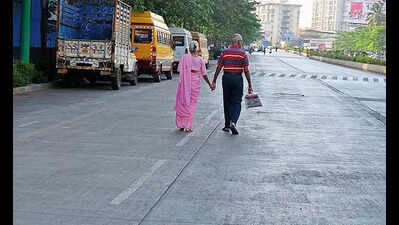- News
- City News
- mumbai News
- Pavements encroached, roads dug up, seniors stay at home
Trending
Pavements encroached, roads dug up, seniors stay at home
Mumbai's elderly face increasing challenges due to poorly maintained footpaths, rising traffic, and roadworks, making walking unsafe. Many have stopped their daily walks, impacting their health and mobility. The Bombay High Court and BMC recognize the urgency, with a Rs 100-crore allocation for pedestrian infrastructure improvements. Seniors now rely more on technology and assistance for short distances.
MUMBAI: A decade ago, retired Crompton engineer Mukund Vaidya would stroll down every evening to the Parleshwar Temple in Vile Parle East. Back then, recalls the 82-year-old, the roads were rarely dug up and the lanes had much less vehicular movement. "I would walk along the tree-lined streets to the temple and meet my friends," says Vaidya.
Then, a few years ago, his road was dug up for several months for some pipework, forcing Vaidya to stop his daily walks. The situation only got worse. Today, the same lanes are clogged with autos, two-wheelers, and sometimes even trucks carrying construction material, making it unsafe for him to walk on the roads.
Mumbai's footpaths have long been a challenge for its elderly citizens but the increase in traffic and surge in roadworks has made life even more difficult for them. Many seniors say they have stopped their walks---with potential consequences for their mobility, their ability to socialise, and their mental health. "Walking is the best exercise for senior citizens, but it has turned into an extreme sport," says 64-year-old Prakash Borgaonkar, CEO of Aaji Care Sevak Foundation. "Many are afraid of falling. For those walking with a stick, it's especially challenging."
Adds Dr Anita Kumar, consultant geriatrician at Holy Family Hospital, "Aging should not mean being confined indoors due to poor infrastructure."
And when the elderly do step onto the road, they have to contend with both fat SUVs and an increasing number of two-wheelers that swarm even smaller lanes. According to a 2017 study titled An Investigation into the Walkability Problems of Indian Cities, even areas in the older and better planned parts of the city such as Breach Candy and Churchgate can be challenging for pedestrians.
The Bombay High Court has recognized the urgency of addressing the footpath issue. In February 2023, the court stressed the need for a systematic approach to make Mumbai's footpaths free of encroachments and more pedestrian-friendly, particularly for the disabled and senior citizens. This year, the BMC has allocated Rs 100-crore to improve pedestrian infrastructure in the city.
In the meantime, the deterioration in walkability means that many senior citizens now prefer walking within the safety of their residential complexes. Some are lucky enough to have nearby parks--indeed, ‘Nana Nani' parks have become increasingly popular in the city.
But walking for errands nearby is becoming difficult. Seniors who are adept with technology and can afford it, like 75-five-year-old Geeta Deshpande, now use Ola and Uber for even short distances. "It's not just that the roads are difficult to walk on, but it also gets exhausting to walk short distances due to the weather, the overwhelming number of vehicles, and, of course, my age," Deshpande says.
Some elderly citizens find themselves relying more and more on others. In Kurla West, Shabana (77), who is a widow, says she doesn't often step out of the house but when she does, she takes help from her neighbours. "Last year, I had terrible knee pain and could barely walk. My neighbour's son, who is an auto driver, took me in his auto to the doctor," says the former domestic worker.
Doctors say it's important for seniors to continue walking as much as possible. A mix of social support and personal precautions, such as wearing shoes with a good sole and ankle support or using walking sticks, can help seniors remain active and independent as long as possible, says Dr Kumar, who is also author of a book on eldercare, titled ‘Narratives of a Geriatrician: Stories of eldercare and caregiving'.
Better infrastructure is also key, say activists, especially footpath accessibility and safety. "The municipality must take note," says Aaji Care's Borgaonkar. "If the city aims to be age-friendly, its pavements must be too."
(This is part of an ongoing series on pedestrian issues in Mumbai.)
End of Article
FOLLOW US ON SOCIAL MEDIA








